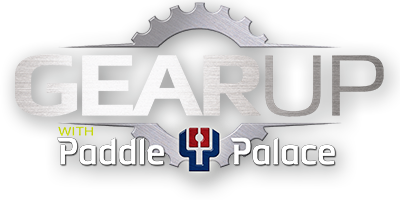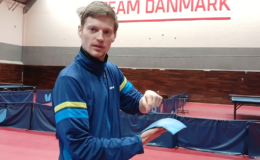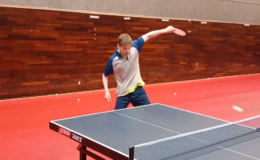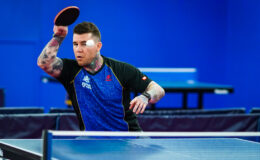By Larry Hodges, USATT Hall of Famer and Certified National Coach
So you have a big upcoming tournament a few months away, and want to prepare yourself to be at your best? Welcome to the world of training cycles.
Some players train the same way all year, and as a result they show steady improvement. However, that improvement comes about because of the sheer amount of training. Often these players lose at big tournaments to those who don’t necessarily train more, but train smarter.
So how can you best prepare yourself for a big tournament coming a few months away? The first step is to assess where you are now, and where you want to be. Be honest with yourself: where is your game right now? Where do you want it to be for the big tournament? What parts of your game need improvement?
Break your game down into five parts: physical fitness, serves, receives, strokes & footwork (these go together), and sports psychology. Divide each of these into strengths (or potential strengths) and weaknesses. If it’s borderline, perhaps think of it as a potential strength. (I’m talking more about the first four items; see info below on sports psychology.)
You need to put equal emphasis both on improving your weaknesses and on turning your strengths into overpowering ones. How do you turn a strength into an overpowering strength? Both by practicing the strength and by practicing the techniques that will get it into play. (Having a great loop isn’t nearly as valuable if you don’t have serves and receives that set it up, for example.)
Decide where each of these items are now, and where they need to be for the big tournament. Once you’ve made that assessment, you are ready to begin. It’s always good to know where you are going before you begin.
You will now start a gradual progression where you start out by focusing on practicing the raw ingredients of your game (fitness, serve, receive, strokes & footwork), and gradually transition to match-type play. Here’s a rough breakdown.
Fitness: What’s your current fitness level, and where do they need to be for the big tournament? Do you need to work on general conditioning, weight training, stretching? Start out by doing longer but easier workouts, and gradually transition to more intense ones. For general conditioning, you can do running, cycling, or similar exercises, or you can focus on combining it with your table tennis by doing extensive footwork drills. (This saves time.) Weight training and stretching are musts for truly serious players, and are especially important as you get older.
Serves: How effective are your serves now, and where do they need to be for the big tournament? Do they consistently put pressure on your opponent while setting you up for your best shots? Start out by working on many varied serves. Get a box of balls and practice! Experiment, trying out different variations and copying others you have seen. Test them out in matches. As the big tournament approaches start to simplify by focusing on the ones you think will be most effective for you. (You might be developing other serves that won’t be ready for the big tournament; put them aside, and go back to developing them afterwards.) Make sure you have lots of variations ready for different opponents with different receiving strengths and weaknesses.
Receives: How effective is your return of serve now, and where does it need to be for the big tournament? Can you consistently make good receives that stop the opponent from doing what he wants to do while setting you up to do what you want to do? Just as with serves, experiment with many varied receives and test them out in matches. As the big tournament approaches start to simplify by focusing on the ones you think will be most effective for you. Use matches to get feedback on what you need to develop. Ideally practice your receives in drills with a partner with good serves, who just serves over and over so you can practice your receive. (Playing out the point or keeping score is optional.) Otherwise you’ll have to develop them in actual matches.
Strokes & Footwork: How strong are your strokes and footwork now, and where do they need to be for the big tournament? The two go together because you have to move to stroke; you can’t have one without the other. The bulk of your practice will likely involve both. Early on focus on the basics, with lots of rote drills, i.e. drills where you know where the ball is going, such as side-to-side footwork. Make sure to use the same strokes you plan to use in the big tournament – if you are a looper, then do footwork drills where you loop; if you are a hitter, do footwork drills where you hit, etc.
As the big tournament approaches the emphasis should gradually change to more random drills and match-type drills. Random drills are ones where you don’t know where the next ball is going. For example, your partner might put the ball randomly to your forehand or backhand, and you have to react. Or he might put the ball randomly all over your forehand side, and you have to react and move to loop or hit your forehand. Match-type drills mimic match conditions, and generally start out with a serve and receive. For example you might serve short backspin, your partner pushes long to your backhand, you loop to his backhand, he blocks to your forehand, and then it’s free play. There are countless variations; examine what type of patterns you use in your game, and develop drills that match that.
Here is an article Six-Step Training Progression which covers the transition from basic strokes and footwork drills to more advanced ones.
Sports Psychology: All the training in the world won’t help you if you show up too nervous to play or in some other way not ready to mentally compete at your best. Here are some resources on sports psychology.
Putting It All Together: As the big tournament approaches, it’s time to put it all together. Now is the time to focus on lots of matches where you use what you’ve been practicing. The matches not only fine-tune your game, but also provide feedback as to what needs more work as well as what tactics you will be using in the big tournament.
The Gradual Transition: I want to emphasize that you don’t only do basic rote drills at the start or only random and match-type drills at the end. You should be doing all of these drills in your training. It’s a matter of degree as well as level. (Higher-level players will do more random and match-type drills early on, while beginners need more rote drills.) As the big tournament approaches, you increase the amount of random and match-type drills. You should also increase the intensity of the drills, often by doing more drills but for less time each.
The Big Tournament: The day finally arrives. You’ve prepared for this for months. Now is where the training pays off. To maximize your success here’s a Ten-Point Plan to Tournament Success. Good luck!



